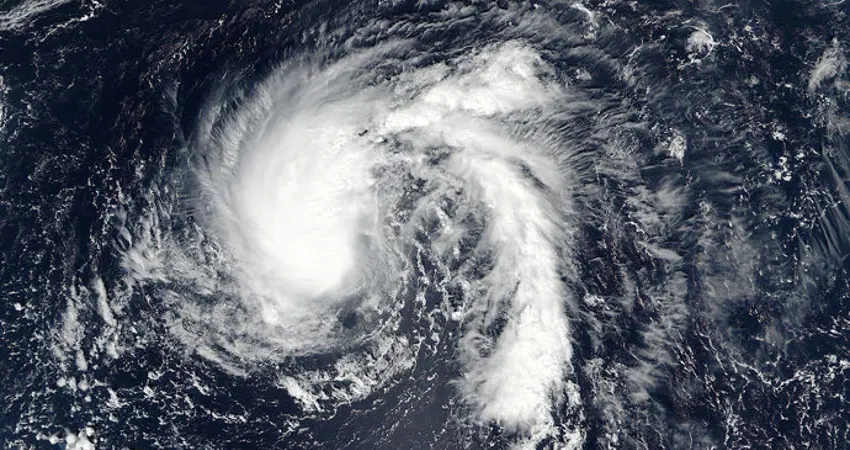18 Jun 2019
Oxford e-Research Centre teams up with ECMWF to enable scientists to run the OpenIFS weather model on thousands of people’s home computers
The OpenIFShome project was launched on 18 June during this year’s OpenIFS user workshop at the University of Reading.

Scientists will be able to study events such as tropical storm Karl, which developed in the Atlantic in September 2016, using the OpenIFShome project. (Image: NASA Visible Earth, LANCE/EOSDIS Rapid Response team)
OpenIFShome brings together two powerful tools: OpenIFS, an easy-to-use, supported version of ECMWF’s Integrated Forecasting System (IFS) widely used in research and education; and Climateprediction.net (CPDN) at the University of Oxford, a highly successful volunteer computing project that has been running since 2003.
“CPDN has benefited from the power provided by more than 600,000 home computers over the last 15 years and currently has about 32,000 active volunteers on board,” says Professor David Wallom, who oversees innovation at the Oxford e-Research Centre (Department of Engineering Science).
“By exploiting the distributed computing power provided by tens of thousands of volunteers, CPDN can run weather and climate experiments that would be too computationally demanding even for supercomputers,” he points out.
David explains that such computing power is required when scientists want to run thousands of slightly perturbed versions of a model for the same event.
“Very large ensembles of weather and climate simulations are essential to study the predictability of extreme events,” says Antje Weisheimer, an ECMWF scientist who also works at the University of Oxford.
Antje gives the example of Karl, a tropical storm that developed in the Atlantic in September 2016. The NAWDEX field campaign observed the storm as it interacted with the jet stream.
“This storm attracted a lot of interest among researchers studying the reasons for weather forecast busts in Europe,” Antje says.
“In order to study the predictability of such storms and their impact on subsequent weather in Europe, we need to run thousands of slightly perturbed simulations, and this is where CPDN comes in.”
The OpenIFS workshop from 17 to 21 June is devoted to the impact of moist processes on weather forecasts and will include work on Karl.
On 18 June, David opened an OpenIFS experiment on Karl to some 8,000 CPDN volunteers who have Linux capabilities on their computers.
At the end of the week, the results will be compared with the outcome of a similar experiment run on ECMWF’s high-performance computing facility.
OpenIFShome represents a new departure for both OpenIFS and CPDN.
“The project offers unprecedented possibilities for users of OpenIFS,” says Glenn Carver, who leads the OpenIFS project at ECMWF.
“If they have limited access to supercomputers or wish to carry out experiments with very large ensembles, OpenIFShome could be for them,” he says.
Marcus Köhler of the OpenIFS team notes that currently OpenIFShome experiments are limited to a grid spacing of about 125 km.
But he adds that the maximum horizontal resolution is expected to increase in the future. “As the computing power of home computers increases, it should become possible to carry out higher-resolution experiments using OpenIFShome,” he says.
Dr Sarah Sparrow, the Programme Coordinator for the CPDN project, notes that OpenIFShome marks a significant expansion of the programme.
“We had some discussions on the need to move towards a multi-model capability, and OpenIFS seemed like a good choice to expand the CPDN model portfolio.”
She adds that there is a link with CPDN’s traditional focus on climate since in the future it will be possible to use OpenIFS for extreme event attribution studies. Such studies seek to determine how the probability of occurrence of specific weather events is affected by climate change.
“Contact with the OpenIFS team at ECMWF was made through Antje, who is based in the Department of Physics at the University of Oxford as well as at ECMWF. The collaboration with ECMWF has been excellent and we look forward to OpenIFShome being put to good use for the benefit of cutting-edge weather and climate research.”
ECMWF Director of Forecasts Florian Pappenberger welcomed the availability of OpenIFS on CPDN. He said: “I’d like to thank all those involved for the work that has gone into this project. OpenIFShome will facilitate vital research into the predictability of high-impact weather, which will ultimately lead to better weather forecasts for our Member and Co-operating States.”
Scientists interested in using OpenIFS on CPDN should fill in the OpenIFShome new collaboration enquiry form on the CPDN website.




